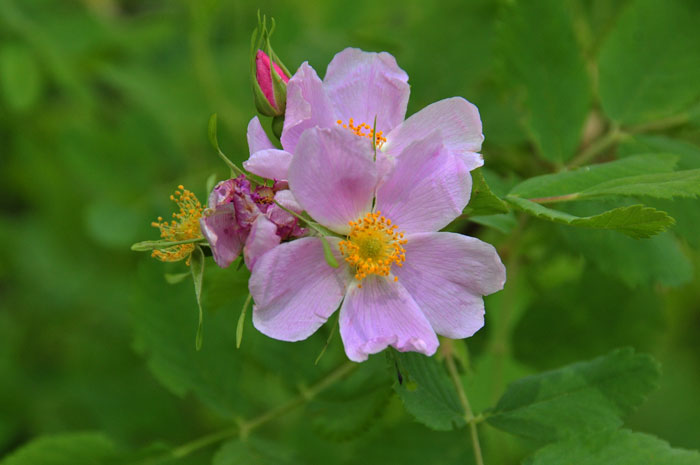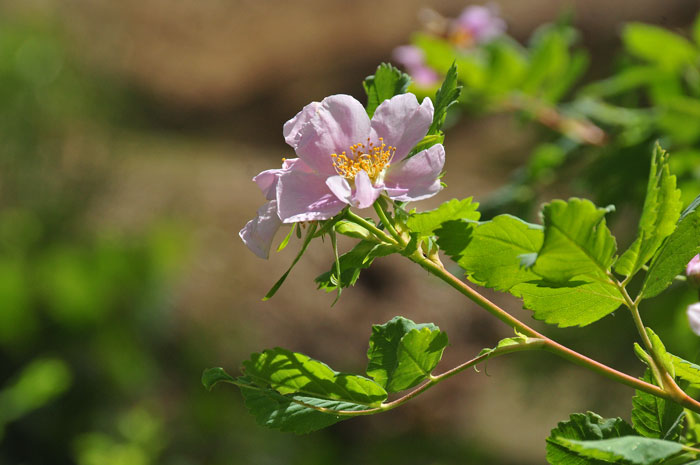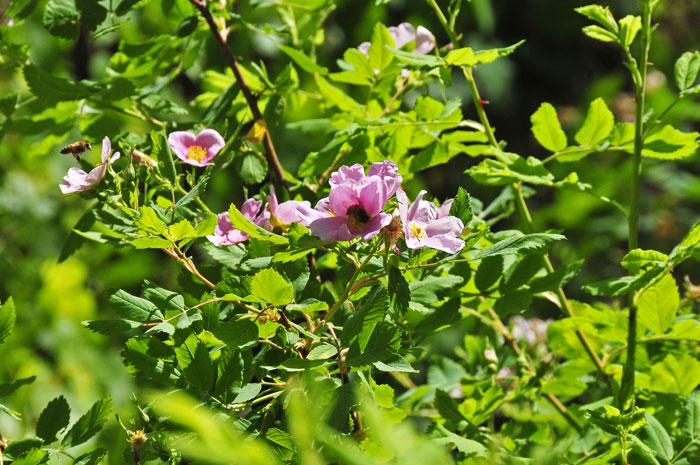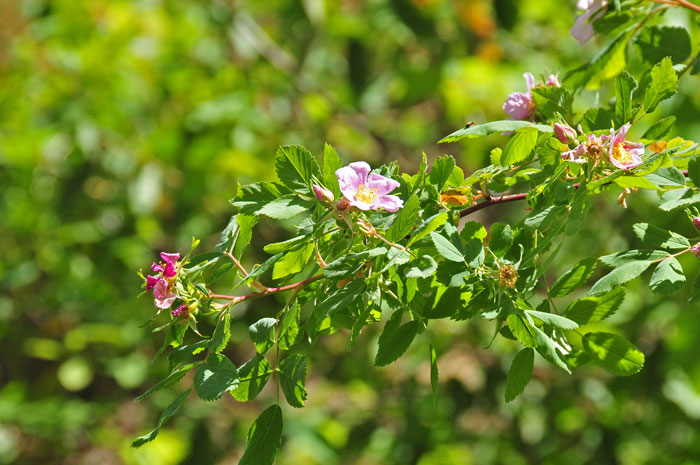Rosa woodsii, Woods Rose




Scientific Name: Rosa woodsii
Common Name: Woods Rose
Also Called: Fendler Rose, Interior Rose, Mountain Rose, Pearhip Rose, Tehachapi Rose, Western Wild Rose, Wild Rose, Wood's Rose, Woods' Rose
Family: Rosaceae or Rose Family
Synonyms: (Rosa deserta, Rosa foliolosa var. leiocarpa, Rosa sandbergii, Rosa subnuda, Rosa woodsii subsp. woodsii)
Status: Native
Duration: Perennial
Size: Up to 6 feet or so.
Growth Form: Shrub, subshrub; open multiple branches or forms dense thickets; stems gray or reddish-brown, prickles on lower parts, fewer prickles than other wild roses.
Leaves: Green; alternate, deciduous; pinnately compound, 5 to 9 leaflets, leaflets up to 2 inches; shape is variable elliptic to obovate; margins sharp single-teeth.
Flower Color: Pink, deep rose; 2 inch showy flowers, medium size; solitary or in clusters, flowers followed by many orange-red rose hips; pedicels up to ¾ inch long; glabrous; sepals with long linear lobes, persistent and mostly erect; 5 petals pink to deep rose; fruits achenes within the rose hip.
Flowering Season: May to July in Arizona, California and Washington.
Elevation: 4,000 to 9,000 feet; 2,500 to 10,000 feet in California.
Habitat Preferences: Along streams and in pine forests, in partial shade; moist areas.
Recorded Range: Rosa woodsii is found primarily in the west ½ of the United States and AK, throughout all of lower Canada north to the Yukon Territories and Northwest Territories.
North America & US County Distribution Map for Rosa woodsii.
U.S. Weed Information: No information available.
Invasive/Noxious Weed Information: No information available.
Wetland Indicator: No information available.
Threatened/Endangered Information: No information available.
In Arizona there are 2 species of Rosa, in California there are 13 species, Nevada has 2 species, New Mexico has 8 species, Texas has 12 species, Utah has 5 species. All data is approximate and subject to taxonomic changes.
There are 4 varieties in Rosa woodsii;
Rosa woodsii var. glabrata, Woods' Rose (CA);
Rosa woodsii var. gratissima, Tehachapi Rose (CA, NV);
Rosa woodsii var. ultramontana, Woods' Rose (CA, CO, ID, MT, NM, NV, OR, UT, WA - Canada BC) ;
Rosa woodsii var. woodsii, Woods' Rose ( AZ, CO, IA, KS, MN, MT, NE, ND, NM, OK, SD, TX, WY - Canada AB, MB, NT, ON, QC, SK, YT).
Comments: Rosa woodsii is extremely variable with 4 varieties and widely distributed; in Arizona it is found throughout most of the state above 4,000 feet. This is one of our most abundant roses and it has a special value to native bees. Wood's Rose is an important late summer, fall and winter food source for upland game birds, non-game birds and small mammals.
For a comprehensive thoroughly documented review of Rosa woodsii see the USDA USFS Fire Effects Information System, or FEIS.
Rosa woodsii has been heavily used for food and a variety of other purposes by North American indigenous peoples.
Arapaho Drug, Antirheumatic (External), Seeds used to produce a drawing effect for muscular pains.
Arapaho Dye, Orange, Root used to make an orange dye.
Lakota Food, Fruit, Rose hips used for food.
Montana Indian Food, Fruit, Fruit used for food.
Okanagan-Colville Drug, Ceremonial Medicine, Decoction of leaves, branches and other boughs taken and used as body and hair wash by sweatbathers.
Paiute Drug, Antidiarrheal, Decoction of root taken by adults and children for diarrhea.
Shoshoni Drug, Blood Medicine, Compound decoction of roots taken as a blood tonic and for general debility.
Thompson Drug, Antiemetic, Decoction of branches, choke cherry and red willow taken for vomiting.
See ethno-botanical uses at Native American Ethnobotany, University of Michigan, Dearborn.

